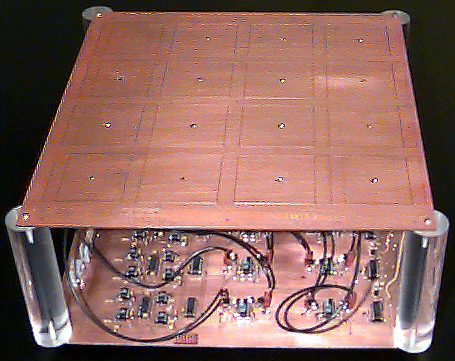The ScanFish

This device, termed the "ScanFish", is a programmable array of 4 x 4 electrodes designed for investigating electric field imaging. Each electrode can dynamically be assigned to be a transmitter or a receiver of an AC electric field, enabling electric field tomography of objects above the antenna array. The above photograph shows the device configured for operation, with all electronics below and the 4 x 4 electric field antenna above. It was driven by a standard National Instruments data acquisition card mounted in a PC. A technical manual is linked here that details the design and operation of the hardware.
This system was used in the initial research into electric field imaging that was carried out in the old Physics and Media Lab back in 1995 and 1996. Our RA at the time, Josh Smith, developed code to drive this device, and produce the original, crude "blobby" images of hands above the table (unfortunately, we never took any screen shots of the pictures produced by this system - it was a popular demo back then, however, and we often ran it live for visitors). Josh went on to design his "School of Fish", an array of smart electrodes on a common RS-485 bus loosely inspired by the Rhythm Tree system designed for the Brain Opera, which he subsequently used in his PhD thesis.
The term "Fish" was used because fish are known to use electric fields to sense objects (and other fish) underwater. The original Fish circuit was a simple 4-channel electric field sensing board designed by Joe Paradiso and Tom Zimmerman - many were made, and they were used throughout the Media Lab and sponsor community for contactless gesture-sensing applications during the mid-late 90's.

